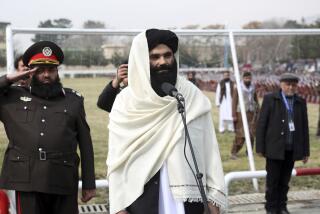U.S. Seeks Signs of Split in Taliban
- Share via
WASHINGTON — In a campaign combining diplomacy, publicity and covert funding, the Bush administration is sending a last-minute message to tribal leaders inside Afghanistan: Abandon the Taliban or face American military force.
The U.S. objective, officials say, is to weaken or even topple the Taliban regime before the first shot in the war on terrorism is fired.
But so far, the results are uncertain. “We haven’t seen any sign in the past week of the kind of major shift we might hope for,” acknowledged a State Department expert on Afghanistan.
The U.S. has delivered its message from the top, through President Bush, British Prime Minister Tony Blair and Pakistani President Pervez Musharraf, all of whom have warned in the past two days that the Taliban’s days are numbered.
Officials say that the same message is also being conveyed more concretely on the ground through Pakistani officials and U.S. intelligence agents: Afghans who switch sides can count on money and other help from the United States, and perhaps even a place in a post-Taliban government, but those who stay with the Taliban should be ready to fight.
The Central Intelligence Agency “is doing a lot of hard work to persuade people in Afghanistan to reconsider their chosen path,” one official said. “We hope it succeeds.”
He refused to provide details, but several officials acknowledged that the CIA has been authorized to offer money and support to would-be defectors from the Taliban side.
“Bribing people to defect from one side to another has been going on for a long time in Afghanistan, and the same process is going on now,” one official said.
The United States and Pakistan are focusing on two key groups: possible “moderate” elements within the militant Taliban movement and traditional tribal leaders who have supported the Taliban as a matter of convenience more than ideology.
“There has always been a division between the mullahs [Muslim clergy] who are the Taliban’s main base of support and the traditional leaders,” the State Department official said.
Secretary of Defense Donald H. Rumsfeld, in an interview with ABC television, said he saw signs of a split at the heart of the Taliban regime.
“There are . . . factions within the Taliban that disagree with [Mullah Mohammed] Omar and the Taliban leadership with respect to its coddling and assisting of the Al Qaeda terrorist group,” Rumsfeld said. “So there are factions within factions, and certainly it’s our interest to see that the factions that are in favor of the Afghan people and who are against international terrorism are the ones that prevail.”
But other officials warned that the evidence of internal division within the regime was far from clear.
“The signs point in every possible direction,” one official said. “There are indeed signs of cracks and fissures, but nothing you’d call a crevasse. We don’t take too much comfort from that. When a regime is under pressure, you expect to see some cracks.”
In Islamabad, Pakistan’s capital, officials said they were trying to persuade moderate elements of the Taliban government in neighboring Afghanistan either to defect or to meet the U.S. demand to surrender terrorist suspect Osama bin Laden and his aides.
“One way or another, we need to convey to the [moderate] Taliban where Bin Laden stands,” a high-ranking Pakistani source said after U.S. Ambassador Wendy Chamberlin presented Musharraf with evidence regarding the case against the Saudi-born militant.
Pakistan in recent days has helped to identify several dozen figures in the Taliban government and the Afghan diaspora who might be of use in forming a new post-Taliban government, the same source said.
The United States has supported a joint effort by Afghanistan’s 86-year-old exiled king, Mohammed Zahir Shah, and the country’s main opposition force, the Northern Alliance, to form a new government.
The Northern Alliance, also known as the United Front, and the former monarch agreed Monday to name a 120-member Supreme Council for National Unity representing all Afghan tribes and ethnic groups, and call it into session in Rome by the end of the month.
But the effort faces several problems. The Northern Alliance is made up almost entirely of Tajiks and other northern ethnic groups, traditional rivals of the Pushtuns, who are the Taliban’s base of support. The king and many of the exile groups that support him have been in only intermittent touch with people inside the country.
That’s why the United States and Pakistan are now focusing on groups inside Taliban-ruled areas, such as the tribal leaders.
But the Taliban, apparently recognizing its potential political vulnerability, has moved to shore up support. On Monday, it announced a power-sharing deal that would give government positions to representatives of minority southern tribes in several strategic border provinces.
“It’s probably a mistake to talk about the Taliban in categories like moderate and radical,” said Paula R. Newberg, a South Asia expert and U.N. consultant. “The more significant factor is likely to be the border tribes whose job it has been for decades to mediate” between the interior and the outside world.
Newberg said U.S. efforts to woo defectors may suffer from the view held by many Afghans that the United States, which supported their fight against the Soviet Union in the 1980s, lost interest in their country once the Soviets left.
“The United States is trying to communicate to people who might be thinking about jumping ship that there’s a place for them to jump to,” she said. “But it’s not clear that these people will see the United States as the most reliable ally.”
*
McManus reported from Washington and Daniszewski from Islamabad.
More to Read
Sign up for Essential California
The most important California stories and recommendations in your inbox every morning.
You may occasionally receive promotional content from the Los Angeles Times.














